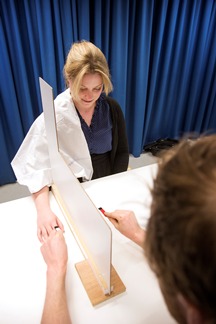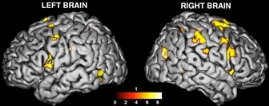Almost everyone who has had an arm or leg amputated experiences a phantom limb, a vivid sensation that the missing limb is still present, like having an itch.
Neuroscientists at the Karolinska Institutet in Sweden have shown that it isn't just for amputees - the sensation of having a physical body is not as self-evident as we might think and have evoked the illusion of having a phantom hand in non-amputated individuals.
In their Journal of Cognitive Neuroscience article the researchers describe a perceptual illusion in which healthy volunteers experience having an invisible hand.
The experiment involved the participant sitting at a table with their right arm hidden from their view behind a screen. To evoke the illusion, the scientist touches the right hand of the participant with a small paintbrush while imitating the exact movements with another paintbrush in mid-air within full view of the participant.

Photo: Gustav Mårtensson
"We discovered that most participants, within less than a minute, transfer the sensation of touch to the region of empty space where they see the paintbrush move, and experience an invisible hand in that position," says Arvid Guterstam, lead author of the study. "Previous research has shown that non-bodily objects, such as a block of wood, cannot be experienced as one's own hand, so we were extremely surprised to find that the brain can accept an invisible hand as part of the body."
The study comprises eleven experiments that explore in detail the illusory experience and include 234 volunteers. To demonstrate that the illusion actually worked, the researchers would make a stabbing motion with a knife towards the empty space "occupied" by the invisible hand and measure the participant's sweat response to the perceived threat. They found that the participants' stress responses were elevated while experiencing the illusion but absent when the illusion was broken. In another experiment, the volunteers were asked to close their eyes and quickly point with their left hand to their right hand (or to where they perceived it to be). After having experienced the illusion for a while, they would point to the location of the invisible hand rather than to their real hand.
The researchers also measured the brain activity of the participants using functional magnetic resonance imaging (fMRI). Perceiving the invisible hand illusion led to increased activity in the same parts of the brain that are normally active when individuals see their real hand being touched or when participants experience a prosthetic hand as their own.

Areas of the brain activated when participants experience the invisible hand illusion. Image: Arvid Guterstam
"Taken together, our results show that the sight of a physical hand is remarkably unimportant to the brain for creating the experience of one's physical self," says Arvid Guterstam.
The researchers hope that the results of their study will offer insight into future research on phantom pain in amputees.
"This illusion suggests that the experience of phantom limbs is not unique to amputated individuals, but can easily be created in non-amputees," says the principal investigator, Dr. Henrik Ehrsson, docent at the Department of Neuroscience. "These results add to our understanding of how phantom sensations are produced by the brain, which can contribute to future research on alleviating phantom pain in amputees."
Citation: Arvid Guterstam, Giovanni Gentile and Henrik Ehrsson, 'The invisible hand illusion: Multisensory integration leads to the embodiment of a discrete volume of empty space',
Journal of Cognitive Neuroscience, online 11 April 2013, doi:10.1162/jocn_a_00393




Comments